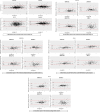Diagnostic and analytic performance of four point-of-care hemoglobin testing devices used in routine HIV and maternity care in Uganda
- PMID: 40913232
- PMCID: PMC12412240
- DOI: 10.1186/s12913-025-13354-9
Diagnostic and analytic performance of four point-of-care hemoglobin testing devices used in routine HIV and maternity care in Uganda
Abstract
Background: Hemoglobin estimation (Hb) is the most requested hematology test, especially among pregnant/postnatal women and people living with HIV (PLHIV). In Uganda, several point-of-care (POC) Hb testing devices are currently used and performance may be affected by multiple factors. This study evaluated the diagnostic and analytic performance of four Hb POC devices.
Methods: During October 2021-April 2022, four POC Hb devices (HemoCue Hb 301, DiaSpect Tm, Hemo Control, and VERI-Q Red) were evaluated against the Beckman Coulter as gold standard at four sites: Rakai Health Sciences Program clinic/Kalisizo General Hospital, Mbarara Municipal Council Health Center IV, Mpigi Health Center IV, and Atutur Hospital. Adult, consented participants aged ≥ 18 years, provided 4 mL of venous blood for concurrent Hb testing across the POC Hb devices. Anemia classification followed World Health Organization guidelines: <11.0 g/dl for pregnant women, < 12.0 g/dl for non-pregnant adult women, and < 13.0 g/dl for adult men. The Bland-Altman method was used to assess the agreement of Hb results (mean difference, standard deviation of differences, and limits of agreement). Diagnostic accuracy parameters (sensitivity, specificity, positive predictive value, negative predictive value, and accuracy) were calculated to evaluate the performance of each device compared to the reference machine.
Results: A total of 768 participants (192 from each site), comprising equal numbers of PLHIV and pregnant/postnatal women were recruited. Participants' mean (SD) Hb values were 12.1 (± 2.2) g/dl. There were strong positive correlations (all r ≥ 0.9) between each POC Hb device and the Beckman Coulter. The mean difference between POC Hb devices and Coulter readings across sites was 0.06 for the HemoCue Hb 301, 0.16 for VERI-Q Red, 0.35 for Hemo Control, and 0.57 for Diaspect Tm, with the Diaspect Tm showing the broadest limits of agreement (-0.76,1.91). The DiaSpect Tm, Hemo Control, HemoCue Hb 301 and VERI-Q Red were at least 94% (79%), 88% (87%), 77% (91%) and 75% (76%) sensitive (specific), respectively, across the study sites.
Conclusion: All devices demonstrated clinically acceptable performance (within ± 1 g/dL of the reference hemoglobin), with the HemoCue Hb 301, DiaSpect Tm and Hemo Control performing most comparable to the standard, suggesting potential for interchangeable use.
Keywords: Analytic; Diagnostic; HIV; Hemoglobin; Maternity; Point of care; Uganda.
© 2025. The Author(s).
Conflict of interest statement
Declarations. Ethics approval and consent to participate: This study was reviewed and approved by Uganda Virus Research Institute, Research and Ethics Committee (Ref. GC/127/720), Uganda National Council for Science and Technology under # HS437ES, as well as CDC and was determined not to be research, and was conducted consistent with applicable federal law and CDC policy 45 C.F.R. part 46.102(l)(2), 21 C.F.R. part 56; 42 U.S.C. § 241(d); 5 U.S.C. § 552a; 44 U.S.C. § 3501 et seq. Consent for publication: Not applicable. Competing interests: The authors declare no competing interests.
Figures
References
-
- Organization WH. Haemoglobin concentrations for the diagnosis of anaemia and assessment of severity. Vitamin and Mineral Nutrition Information System. No Title); 2011.
-
- Mukaya JE, Ddungu H, Ssali F, O’Shea T, Crowther MA. Prevalence and morphological types of anaemia and hookworm infestation in the medical emergency ward, Mulago hospital, Uganda. South Afr Med J. 2009;99(12):881–6. - PubMed
-
- Ssali F, Stöhr W, Munderi P, et al. Prevalence, incidence and predictors of severe anaemia with zidovudine-containing regimens in African adults with HIV infection within the DART trial. Antivir Ther. 2006;11(6):741–50. - PubMed
-
- Briggs C, Kimber S, Green L. Where are we at with point-of-care testing in haematology? Br J Haematol. 2012;158(6):679–90. - PubMed
MeSH terms
Substances
LinkOut - more resources
Full Text Sources
Medical
Miscellaneous




